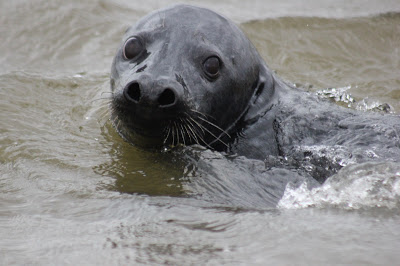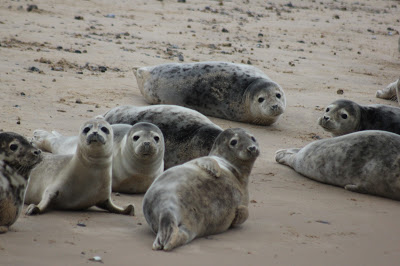|

|
|
This seal seemed really interested in close up views of us
|
East Anglian countryside is wondefully varied as a drive north from Cambridge shows. Yes, Cambridgeshire is green and beautiful but it is Fen-flat so only rarely are you treated to be good view. There are other things to bring a smile to the face though. The first was driving past the village of Fakenham which sounds to me like an ancient Saxon curse, and on north through sumptuous poppy-fields of the Brecks and vistas of gnarled Scots Pines with their backs bent against the prevailing winds. On again through Little Snoring – yes there really is a village called Little Snoring, as well as Great Snoring, and sleepy places they do seem to be.
Scanning the map en route, there are a great number of Norfolk and Suffolk villages with an ing in the name, often in the middle: like Sandringham. Ing means “son of” so that when a Saxon chieftain’s son set up his own settlement (a ham), his father’s village might be called Wallsham and his son’s – usually within five miles – would be Wallsingham, but often the father’s settlement will have disappeared over time.
The roads of North Norfolk are a delight to drive. There are plenty of surprises too. We paused at the 12th century castle that gives Castle Acre its name. The crumbling walls are now decorated by Dog Roses and many of the rest of the fortifications are now covered with lush grass, forming banks that are still challengingly steep to ascend. It is an atmospheric place.
Often the roads cut through woodland so lush that the trees form a tunnel. Journey times aren’t fast but being behind the wheel is so much more enjoyable than motorway driving. Our target on this trip was the windmill that is a cosy hotel at Cley Next the Sea – a fine spot to savour the squalls and brooding clouds coming off the North Sea. Here too there are fine sea-marshes which made me recall the excellent atmospheric novel 'Salt' by Jeremy Page that had me wanting to go out and find some samphire to nibble. Instead we ‘made do’ with some delicious piquant lavender bread from the Cley deli.
|

|
|
Some youngsters were a bit nervous as the boat approached
but not for long
|
Cley hasn't actually been "next the sea" since the 17th century; it is about a mile away these days. Striding through the salt-marshes we were treated to views of avocet, hilariously hyperactive plovers and even a Marsh Harrier getting mobbed by 30 or 40 wading birds as it flew off with one of them – probably a shelduck. The high point though was a boat trip from Blakeney to the colony of Grey and Common Seals. It was cold and windy but the occasional faceful of seawater only added to the adventure.
The two species of seals co-exist contentedly. The much larger 'roman-nosed' Grey Seals pup around Christmas time so their youngsters were already huge, and some of the bulls were truly massive: they weigh up to 250kg. The smaller Common Seals have more attractive faces and are due to give birth around about now. The adult males reach a maximum weight of about 120kg. Both species have the most endearing undulating-fat-rippling means of moving on land.